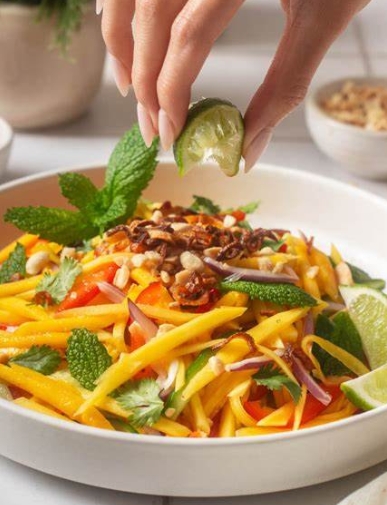Koshari is one of Egypt’s most iconic and beloved comfort foods, often referred to as the country’s national dish. It’s a hearty, flavorful, and satisfying meal that brings together a variety of textures and tastes in one dish. Known for its humble ingredients, Koshari has gained popularity not only in Egypt but across the Middle East and beyond.
The dish is traditionally made by layering lentils, rice, and vermicelli pasta in a bowl, creating a base that’s both filling and nutritious. The combination of grains and legumes provides a hearty foundation, making Koshari a satisfying meal on its own. The dish is then topped with crispy fried onions and served with a generous amount of tomato sauce and a tangy garlic-vinegar sauce, creating a delightful mix of flavors that are savory, tangy, and a bit spicy.
Koshari is known for its simple, affordable ingredients, which are commonly found in Egyptian households. It is often eaten as a quick and filling meal, making it a staple of street food culture in Cairo and other Egyptian cities. The dish can be easily customized based on individual preferences, but the core ingredients of rice, lentils, pasta, and fried onions remain constant.
The lentils used in Koshari are typically brown or black lentils, which give the dish a hearty texture and earthy flavor. The rice provides a soft and fluffy base, while the vermicelli pasta adds a light, slightly crunchy element. The combination of these three staples makes Koshari a well-rounded dish, providing a mix of carbohydrates and protein.
What really elevates Koshari, however, are the toppings and sauces. The crispy fried onions are a signature element, adding a delightful crunch and a deep, caramelized flavor that contrasts beautifully with the softness of the rice and lentils. The tomato sauce is rich and slightly sweet, with a hint of cumin and coriander, giving it a distinctly Egyptian flavor. The garlic-vinegar sauce adds a tangy, aromatic kick that ties everything together and cuts through the richness of the dish.
One of the things that makes Koshari so special is its versatility. While the basic recipe remains the same, it can be customized with additional toppings, such as chickpeas, hot sauce, or even a dollop of yogurt. In some variations, a bit of curry powder is added to the tomato sauce, giving the dish a warm, spicy depth. Koshari can be made vegetarian, or it can be served with meat, such as fried chicken or beef.
Koshari is also a perfect example of Egyptian comfort food. It’s hearty enough to serve as a meal for any time of the day—whether as lunch, dinner, or even a late-night snack. It’s often enjoyed by families, friends, and coworkers, and in Egypt, it’s a dish that brings people together. It’s not just about the flavors and textures; it’s about sharing a meal and enjoying the sense of community that comes with it.
In Egypt, Koshari is often sold at street food stalls and small eateries called koshari shops, where it is made fresh and served quickly. It’s a popular choice for people looking for an affordable, filling meal on the go. Despite its simplicity, Koshari is incredibly satisfying, offering a full meal for just a few pounds. The dish is also a favorite among tourists, who are often introduced to it as part of their exploration of Egyptian cuisine.
The popularity of Koshari extends beyond Egypt’s borders. Over the years, it has found a place in the hearts of people from different parts of the world, particularly those with roots in the Middle East and North Africa. Its comforting, hearty nature makes it a great dish for potlucks, family gatherings, and even restaurant menus looking to offer a taste of Egyptian cuisine.
What makes Koshari even more remarkable is its affordability and accessibility. It’s a dish that can be made with ingredients that are both easy to find and inexpensive, yet the result is a meal that feels substantial and satisfying. In Egypt, Koshari is often enjoyed with bread or served alongside a fresh salad, making it a complete and filling meal.
Ultimately, Koshari is more than just a dish—it’s a representation of Egyptian culture, warmth, and hospitality. The simple yet delicious combination of rice, lentils, pasta, and toppings reflects the importance of family, community, and sharing food in Egyptian life. It’s a dish that tells a story of tradition, resourcefulness, and the power of food to bring people together.





